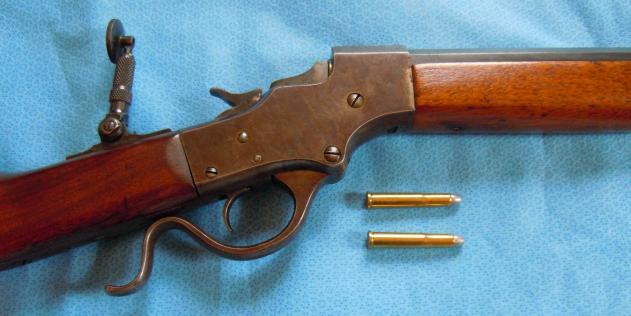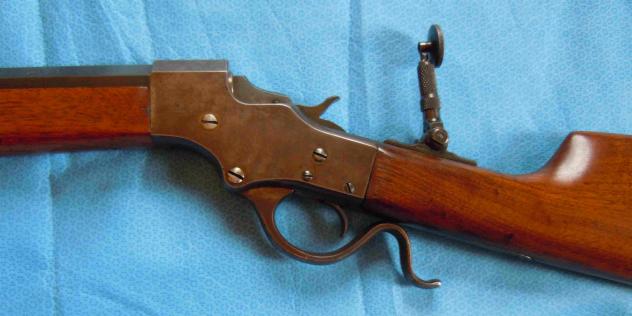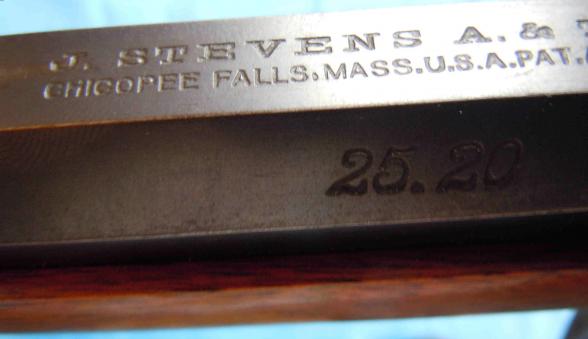Stevens Model 44 series Target Rifle with optional long barrel
Stevens Arms was founded by Joshua Stevens with help from backers W.B. Fay and James Taylor in Chicopee Falls, MA, in 1864 as J. Stevens & Co. Their earliest product was a tip-up action single shot pistol. Business was slow into 1870, when it occupied a converted grist mill and had just sixty employees. The 1873 Panic had a further negative impact on sales. By 1876 the company had recovered to the extent that it was then manufacturing twice the number of shotguns as it had been prior to that year. In 1886, the company was reorganized and incorporated as J. Stevens Arms & Tool Co. The business was able to grow steadily with tool manufacturing and sales now accounting for the bulk of the business output.
Beginning in 1880, the company began making falling block rifles. These, though less well known than Ballard or Winchester firearms, were of comparable quality. They were priced lower than those of Ballard or Winchester, making the Stevens' falling block models competitive in the marketplace. Under names like Favourite, Little Scout, Crack Shot, and Marksman, Stevens sold millions of reliable single-shots. The total number of single-shot firearms manufactured by the company exceeded 3.5 million by 1892.
In addition, in 1887, Stevens developed the .22 LR round which served as an introductory calibre for children for decades, as well as being very popular for plinking, as well as varmint and target shooting. The .22LR cartridge was available beginning in 1888, in the #1, #2, #9, and #10 break-top rifles, and in their New Model Pocket and Bicycle rifles. The .22 LR would outperform other Stevens rounds, such as the .25 Stevens and .25 Stevens Short, designed as competitors, and offered in models such as the lever action single-shot Favourite (produced between 1894 and 1935) and the Crack Shot #15 (introduced in 1900).
As several manufacturers would later do with other wildcats, Stevens adopted the .25-20, developed by Francis J. Rabbeth in 1882. The unpopularity of the bottlenecked case led Stevens to develop the .25-21 in 1897. Designed by Capt. W. L. Carpenter, 9th U.S. Infantry, the .21-21 Stevens was essentially a shortened version of the company's own .25-25 of 1895 (This is an odd reversal of the relationship of the .38 S&W Special to the .357 Magnum.) The .25-25 would be used in Stevens' model 44 and the model 44½ rifles manufactured from 1903. This particular rifle is a series 44 target rifle in 25/20 centre fire calibre and has a 34.1/2 barrel which is the longest barrel Stevens ever manufactured and is seldom encountered. The rifle is fitted with a contemporary Marble tang site and is in excellent condition with a good bore. Should you wish to place this on firearms certificate ammunition is available. You can see examples of the round on one of the photographs and I would be happy to supply an inert round to a collector who did not wish to shoot the rifle.
Stevens and Taylor was bought out in 1896 by I.H. Page, who was one of the new partners and the bookkeeper. Page led the company to significant growth, such that by 1902 Stevens had 900 employees and was considered one of the top sporting firearms manufacturers in the world. In 1915, Stevens led the U.S. arms business in target and small game guns. Stevens military productions and offerings were generally limited to prototypes in an attempt to garner military contracts.
I have other Stevens in stock and can supply breech blocks for centre fire conversion to license holders.
Code: 50211





